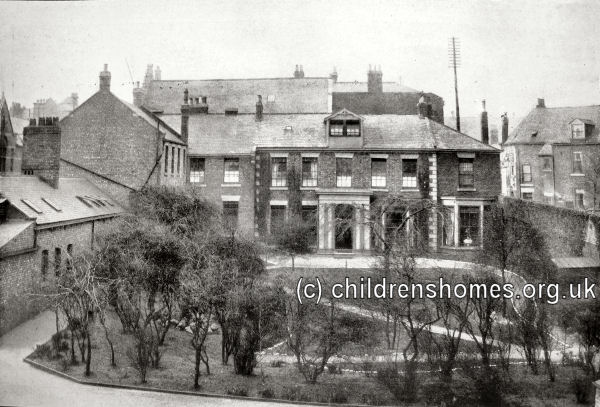Sunderland Reformatory for Girls, Sunderland, Durham
The Sunderland Reformatory School for Girls was established in 1860 on Tatham Street, off Borough Road, Sunderland. Its address was originally given as 6 Tatham Street but in the early 1900s was changed to 3 Tatham Street. The School, housed in a former private residence, was officially certified for operation from June 22nd, 1860, and could accommodate 52 girls aged from 12 to 14 years at their date of admission. Only girls who had been sentenced to at least four years detention were accepted. No charge was made for girls admitted from Durham and Northumberland; for those from other places, a payment of ls. 6d. per week was required.
A press report in 1860 recorded the opening on the institution:
GIRLS' REFORMATORY INSTITUTION AT SUNDERLAND.—This excellent institution, which was formed by John Candlish, Esq., the late Mayor of Sunderland, and has met with liberal support from the gentry of the district, is now established in a commodious mansion in Tatham-street, Bishopwearmouth, which has been purchased by the trustees, and fitted out with dormitories, kitchen, laundry, school room, and every convenience for the reception of 50 inmates. A suitable matron has been engaged; and, already, 17 girls, between 13 and 15 years, have been received into this Reformatory. They are taught reading, writing, arithmetic, and music, knitting, sewing, washing, and the routine of domestic usefulness, so that, in time, these poor outcasts may become useful and industrious members of society.
The School site is shown on the 1897 map below.

Sunderland Reformatory for Girls site, c.1897.

Sunderland Reformatory for Girls from the south-east, Sunderland, early 1900s © Peter Higginbotham
The School's initial intake came from the Sunderland Ragged and Industrial School which, despite its name, had been partly acting as a Reformatory School since 1856.
Girls at the School were given a mixture of classroom education and industrial training. Classroom lessons included mental arithmetic, recitation, geography, singing and gymnastics. By 1903, the girls were being given domestic economy lessons and weekly cookery classes. A country holiday that year in Teesdale gave the girls the chance to try their hand at haymaking. Industrial training including sewing, knitting, laundry work and general housework. The School motivated the girls through a series of competitions in such matters as bread-making, cake-making, metal-cleaning and boot-brushing. The School appears to have enjoyed a very good reputation and former inmates readily found places as domestic servants. In 1906, it was reported that several of the School's old girls had started their own laundries.
In 1903, structural alterations to the buildings included a new play-room and lavatory, extensions to the laundry, and a comfortably fitted "promotion dormitory" for girls displaying good conduct. On June 22nd, 1907, the premises were re-certified to accommodate 56 girls.
The School ceased operation on May 5th, 1919. In 1925-27, a new Seamen's Mission was erected on the former School site.

Seamen's Mission building, Sunderland, 2012. © Peter Higginbotham
Records
Note: many repositories impose a closure period of up to 100 years for records identifying individuals. Before travelling a long distance, always check that the records you want to consult will be available.
- None identfied at present — any information welcome.
Bibliography
- Carpenter, Mary Reformatory Schools, for the Children of the Perishing and Dangerous Classes, and for Juvenile Offenders (1851, General Books; various reprints available)
- Carlebach, Julius Caring for Children in Trouble (1970, Routledge & Kegan Paul)
- Higginbotham, Peter Children's Homes: A History of Institutional Care for Britain's Young (2017, Pen & Sword)
- Abel Smith, Doroth Crouchfield: A History of the Herts Training School 1857-1982 (2008, Able Publishing)
- Garnett, Emmeline Juvenile offenders in Victorian Lancashire: W J Garnnett and the Bleasdale Reformatory (2008, Regional Heritage Centre, Lancaster University)
- Hicks, J.D. The Yorkshire Catholic Reformatory, Market Weighton (1996, East Yorkshire Local History Society)
- Slocombe, Ivor Wiltshire Reformatory for Boys, Warminster, 1856-1924 (2005, Hobnob Press)
- Duckworth, J.S. The Hardwicke Reformatory School, Gloucestershire (in Transactions of the Bristol and Gloucestershire Archaeological Society, 1995, Vol. 113, 151-165)
Links
- Red Lodge Museum, Bristol — a former girls' reformatory.
Except where indicated, this page () © Peter Higginbotham. Contents may not be reproduced without permission.


